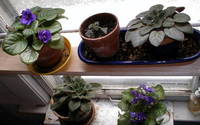Indoor gardening: These plants help clean the air

Our African Violets in better days
Jim Leach | Contributor
The contribution of house plants for cleaning indoor air was explored in the landmark 1989 NASA Clean Air Study, a collaboration between NASA and the Associated Landscape Contractors of America. Most of us are well aware of the fact that plants absorb carbon dioxide and release oxygen, which forms a symbiotic relationship with humans since our breathing does the opposite.
The NASA Clean Air Study found that plants also eliminate significant amounts of benzene, formaldehyde and trichloroethylene from the air. This two-year study suggested that plants might provide a natural way for dealing with “sick building syndrome.”
Some of the most effective plants included English Ivy (Hedera helix), Spider plant (Chlorophytum comosum), Peace Lily (Spathiphyllum 'Mauna Loa'), Chinese Evergreen (Aglaonema modestum), Bamboo Palm (Chamaedorea seifritzii), Snake plant (Sansevieria laurentii), Heartleaf philodendron (Philodendron oxycardium) and several plants in the Dracaena family, including Janet Craig, Marginata and Mass cane/Corn Plant.
Pot Mum (Chrysantheium morifolium) and Gerbera Daisy (Gerbera jamesonii) were also found to be effective air cleaning plants. Further details about individual plants’ specific toxic removal qualities can be found here. The study concluded with the suggestion that 15-18 house plants in six- to eight-inch container sizes would improve the air quality in an average 1,800 square foot home.
Ironically, our house plant population is at an all-time low. A quick inventory reveals one huge Norfolk Island Pine and several offspring in a big pot (which must be re-potted this spring!), two African violets (one thriving, one surviving), one pot of thyme on the rebound from a near-death experience and one cup with basil seeds germinating on the windowsill.
That’s a grand total of five indoor plants — a far cry from the 15-18 needed to filter our indoor air effectively. I’ll be making a concerted effort to expand our indoor plants. Any suggestions?
How many house plants share your home? Does knowing that house plant can improve indoor air quality motivate you to grow them? What plants have you grown successfully? What are your reasons for gardening indoors?
Janice and Jim Leach garden a backyard plot in downtown Ann Arbor and tend the website 20 Minute Garden.


Comments
Jim and Janice Leach
Tue, Mar 15, 2011 : 4:17 p.m.
Thanks, A2K and Prometheus, for sharing your inventories here. I'm really inspired to expand our stock of indoor plants. In particular, I hope to learn more about and become more successful in propagating plants. Interestingly, an article titled "A Superhero Scrubs the Air: The Mighty Houseplant" in today's _Wall Street Journal_ provides an update on the continuing research and publication on the topic of "phytoremediation", which I learned is the proper term for using plants as air purifiers. (I miss the preview function! I hope my link works!)
A2K
Sun, Mar 6, 2011 : 6:56 p.m.
I've always wanted to grow Hoyas - really beautiful the way the leaves are joined to the stems/trailing habit that is very pretty - but where to find one locally?
Prometheus
Sun, Mar 6, 2011 : 3:32 p.m.
Ok then. I just got inspired to run a quick inventory. I'm pretty sure I've met the requirement for air cleaning. Here's what I have on my first floor (I figure 36-37 plants or so): 3 hedera helix, 2 hoyas, 1 rope hoya, 5 pothos, 6 birds of paradise (3 white, 3 red), 2 giant upright alocasias (EE), 2 aloe plants (one huge), 1 large corn dracaena, 1 peace lily, 1 jade plant, 1 giant wandering heart-leaf philodendron, 1 rubber tree, 2 dieffenbachia's, 1 sansevieria (snake plant/mother's-in-law tongue), 1 large warneckei lemon-lime, 1 cordyline dragon tree, 2 dwarf musa varieties (dwarf red musa and truly tiny), 1 unknown winter-blooming (yellow) succulent/cacti, 2 giant unknowns (similar to a chinese evergreen or dieffenbachia), 1 patio-sized lime tree, and 1 pineapple a planted a year ago from the supermarket. I guess there's also the rosemary, mint, and chives on kitchen sill.
A2K
Sun, Mar 6, 2011 : 1:44 p.m.
We currently have 16 orchids (cattleya, phalaenopsis, and zygopetalum) a huge Pothos I've had since I was 14-years-old, 6 varieties of amaryllis, some overwintering rosemary bushes, 15 aloes (started as one aloe from Saguaro Nursery about a decade ago) and a few african violets I saved from Lowe's last year. Most of the plants go outside in the spring, and don't come in again until late September or early October - it really gives them a boost (and primes most of the orchids for flowering in the winter). If you have a hard time making your indoor plant quota, Orchids are terribly addictive - so perhaps you'll make up the air quality in sheer volume (and are they gorgeous when blooming...yum!)